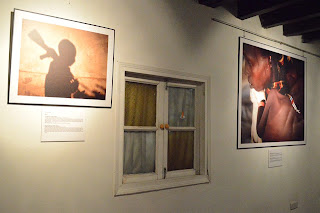by Soh Li Nah
“It is not a pretty film about the MSF heroes or heroines, the idea was more to immerse people in the MSF environment,” said Mark Hopkins, the director of the film, “Living in Emergency- Doctors without Borders”.
“It is not a pretty film about the MSF heroes or heroines, the idea was more to immerse people in the MSF environment,” said Mark Hopkins, the director of the film, “Living in Emergency- Doctors without Borders”.
The screening of above
mentioned film and photo exhibition, which organized by Médecins Sans
Frontières (MSF), took place at The
Annexe Gallery yesterday. The film is a raw and very real depiction of the
dilemmas faced by MSF staff in the field and the toll their work can take on
them both personally and professionally.
This is filmed in the war-zone of Liberia and Congo
with unprecedented access to the field operations of Doctors without Borders,
Living In Emergency follows four volunteer doctors as they sturuggle to provide
emergency medical care under extreme conditions. Here is the film.
This is the very first
time that MSF came to Malaysia to promote MSF values. The “Living in Emergency- Doctors without Borders” screening event
attracted about 100 audiences. ( Retrieved from MSF in SoutheastAsia)
Ability to manage stress
is important
After the 90 minutes film
screening, there is also a Q and A session for audience with three of the
Malaysian MSF representatives: Dr.Tan Day Seng, Wong Siew Weun and Lim Suet
Fong.
From their sharing, they
stated that although there are about 30 of Malaysian volunteers in MSF,
nevertheless, only 10 of them are active. Many are asking about the academic
qualification of becoming a volunteer doctor.
“Actually the academic
qualification is not the most important criteria in our field, because most of
the volunteers just could not stand of the stress in those mal-condition
environments at laggard countries.” Dr. Tan stated. He reiterated that they
would not sanctified MSF to attract people joining their team, as some of the
MSF medical placements are risky and even life threating to volunteers, and not
many volunteers could overcome the hardship of becoming MSF.
Martyn Broghton( right), Director of
Communications MSF was run the screening of the day. Lim Suet Fong( left), Wong
Siew Weun( left second), and Dr Tan Day Seng( right second) were sharing their
experience when working in MSF.
A worldwide movement
Regional Communications
Manager MSF, Lee Pik Kwan said that majority might know that doctors without
borders through dramas, and these are just a lip-deep info. Through these
activities, MSF hope to increase public awareness on humanitarian crisis in
third world countries.
MSF was founded in Paris,
France in 1971. Its principles are described in the organisation's founding
charter. It is a non-profit, self-governed organisation. Today, MSF is a
worldwide movement of 23 associations, bound together as MSF International,
based in Switzerland.Thousands of health professionals, logistical and
administrative staff – most of whom are hired locally – work on programmes in
some 70 countries worldwide.
MSF urged public support
as it always in need of strong and reliable team of staff and volunteers to
help and involve general running of the office. MSF also welcomes donation from
public.
For better understanding and
more detail of this organization, log onto www.msf.org.
Attendant may take a photo
with the model that shows in the exhibition to remember experienced the special
journey of Doctors without Borders.















